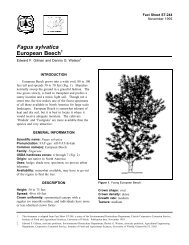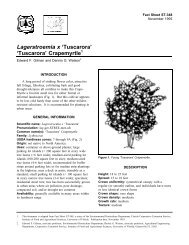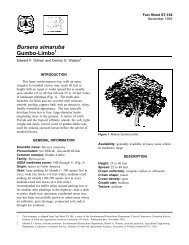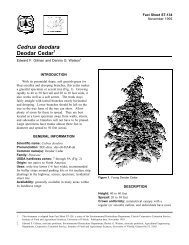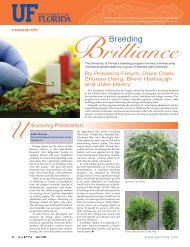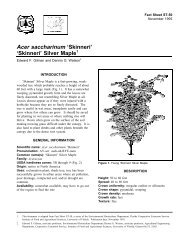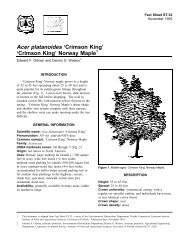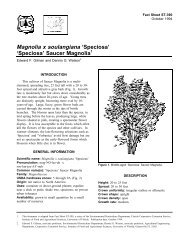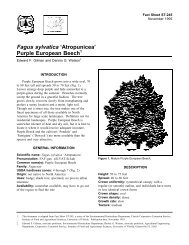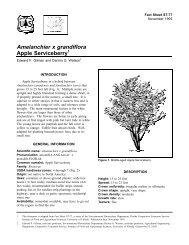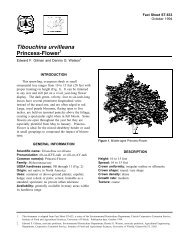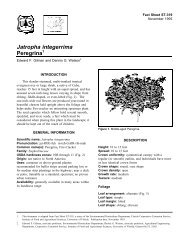Ulmus pumila - Environmental Horticulture - University of Florida
Ulmus pumila - Environmental Horticulture - University of Florida
Ulmus pumila - Environmental Horticulture - University of Florida
Create successful ePaper yourself
Turn your PDF publications into a flip-book with our unique Google optimized e-Paper software.
<strong>Ulmus</strong> <strong>pumila</strong><br />
Siberian Elm 1<br />
Edward F. Gilman and Dennis G. Watson 2<br />
INTRODUCTION<br />
This rapidly-growing deciduous tree has a rounded<br />
canopy with somewhat drooping branches, and reaches<br />
40 to 60 feet in height with a spread <strong>of</strong> 35 to 50 feet<br />
(Fig. 1). The glossy green, two to three-inch-long by<br />
0.5 to 1-inch-wide leaves turn pale yellow in fall<br />
before dropping. The inconspicuous, green, springtime<br />
flowers are produced in small clusters among the<br />
leaves and are followed by half-inch-long, flat, winged<br />
seedpods which mature during early summer. The<br />
wood is fairly brittle and subject to damage during<br />
storms, which creates a lot <strong>of</strong> twig litter on the lawn<br />
afterward. Since major limbs split from the crotches<br />
on older trees, this is considered a tree to avoid. Most<br />
urban tree managers and horticulturists will not<br />
recommend planting this tree. However, recent<br />
observations showed that improper pruning, including<br />
topping, may be partially responsible for the tree’s<br />
weak-wooded reputation.<br />
GENERAL INFORMATION<br />
Scientific name: <strong>Ulmus</strong> <strong>pumila</strong><br />
Pronunciation: UL-mus PEW-mih-luh<br />
Common name(s): Siberian Elm<br />
Family: Ulmaceae<br />
USDA hardiness zones: 5 through 9 (Fig. 2)<br />
Origin: not native to North America<br />
Uses: shade tree<br />
Availability: somewhat available, may have to go out<br />
<strong>of</strong> the region to find the tree<br />
Figure 1. Mature Siberian Elm.<br />
DESCRIPTION<br />
Fact Sheet ST-656<br />
October 1994<br />
Height: 50 to 70 feet<br />
Spread: 35 to 50 feet<br />
Crown uniformity: irregular outline or silhouette<br />
Crown shape: vase shape<br />
Crown density: moderate<br />
Growth rate: fast<br />
Texture: medium<br />
1. This document is adapted from Fact Sheet ST-656, a series <strong>of</strong> the <strong>Environmental</strong> <strong>Horticulture</strong> Department, <strong>Florida</strong> Cooperative Extension Service,<br />
Institute <strong>of</strong> Food and Agricultural Sciences, <strong>University</strong> <strong>of</strong> <strong>Florida</strong>. Publication date: October 1994.<br />
2. Edward F. Gilman, associate pr<strong>of</strong>essor, <strong>Environmental</strong> <strong>Horticulture</strong> Department; Dennis G. Watson, associate pr<strong>of</strong>essor, Agricultural Engineering<br />
Department, Cooperative Extension Service, Institute <strong>of</strong> Food and Agricultural Sciences, <strong>University</strong> <strong>of</strong> <strong>Florida</strong>, Gainesville FL 32611.
<strong>Ulmus</strong> <strong>pumila</strong> -- Siberian Elm Page 2<br />
Figure 2. Shaded area represents potential planting range.<br />
Foliage<br />
Leaf arrangement: alternate (Fig. 3)<br />
Leaf type: simple<br />
Leaf margin: serrate<br />
Leaf shape: elliptic (oval); lanceolate<br />
Leaf venation: pinnate<br />
Leaf type and persistence: deciduous<br />
Leaf blade length: less than 2 inches<br />
Leaf color: green<br />
Fall color: yellow<br />
Fall characteristic: showy<br />
Flower<br />
Flower color: green<br />
Flower characteristics: inconspicuous and not<br />
showy; spring flowering<br />
Fruit<br />
Fruit shape: round<br />
Fruit length: .5 to 1 inch<br />
Fruit covering: dry or hard<br />
Fruit color: brown<br />
Fruit characteristics: does not attract wildlife;<br />
inconspicuous and not showy; fruit, twigs, or foliage<br />
cause significant litter<br />
Trunk and Branches<br />
Trunk/bark/branches: droop as the tree grows, and<br />
will require pruning for vehicular or pedestrian<br />
clearance beneath the canopy; not particularly showy;<br />
should be grown with a single leader; no thorns<br />
Pruning requirement: requires pruning to develop<br />
strong structure<br />
Breakage: susceptible to breakage either at the crotch<br />
due to poor collar formation, or the wood itself is<br />
weak and tends to break<br />
Current year twig color: green; gray<br />
Current year twig thickness: thin<br />
Culture<br />
Light requirement: tree grows in full sun<br />
Soil tolerances: clay; loam; sand; acidic; alkaline;<br />
extended flooding; well-drained<br />
Drought tolerance: high<br />
Aerosol salt tolerance: moderate<br />
Soil salt tolerance: moderate
<strong>Ulmus</strong> <strong>pumila</strong> -- Siberian Elm Page 3<br />
Figure 3. Foliage <strong>of</strong> Siberian Elm.<br />
Other<br />
Roots: surface roots can lift sidewalks or interfere<br />
with mowing<br />
Winter interest: no special winter interest<br />
Outstanding tree: not particularly outstanding<br />
Invasive potential: little, if any, potential at this time<br />
Ozone sensitivity: tolerant<br />
Verticillium wilt susceptibility: susceptible<br />
Pest resistance: very sensitive to one or more pests<br />
or diseases which can affect tree health or aesthetics<br />
USE AND MANAGEMENT<br />
Siberian Elm grows well in full sun on welldrained<br />
soil. This tree is easily grown and will<br />
tolerate a variety <strong>of</strong> adverse conditions, such as poor<br />
soil, drought, and moderate salt. It is probably best<br />
saved for the reclamation site or other out-<strong>of</strong>-the-way<br />
location. It is also useful in climates where many<br />
other trees grow poorly. This could include the drier<br />
parts <strong>of</strong> the central United States.<br />
Propagation is by seed or layering.<br />
Pests<br />
Mites and elm leaf beetles infest this Elm. The<br />
tree is considered weak wooded.<br />
Diseases<br />
Wetwood disease can infect the trunk.



